Hi everyone!
I’ve just uploaded my slideshow onto Youtube. You can watch it by clicking on the icon.
See you all at the Sale! Ilona
Hi everyone!
I’ve just uploaded my slideshow onto Youtube. You can watch it by clicking on the icon.
See you all at the Sale! Ilona
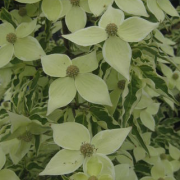 Cornus kousa—Korean Dogwood, cv. Wolf Eyes
Cornus kousa—Korean Dogwood, cv. Wolf Eyes
This is a terrific small variegated Dogwood that makes a perfect focal point in a shady garden. The variegation holds up well and doesn’t burn or darken. The white edges actually turn pinkish in the fall, giving the whole tree a lovely glow. The flowers are numerous, but small and creamy. They last a long time, but are not as noticeable as some of the recent hybrids. This is a tree to grow for its variegated leaves, which really light up a dark corner.
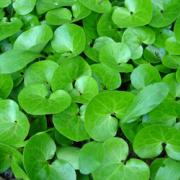 Asarum europaeum—European Ginger
Asarum europaeum—European Ginger
If you are looking for an elegant, well behaved, low evergreen groundcover for full shade, this is a good one to try. It grows 4-6″ tall with glossy dark green leaves, and spreads very slowly from rhizomes. It likes moist soils high in organic matter, but once established it can withstand dry conditions. In early spring it has a globular brownish flower that hangs down underneath the leaves, but you have to get down on your hands and knees to see it. This is a great plant to place at the feet of rhododendrons and azaleas, or any shrubs in the woodland garden.
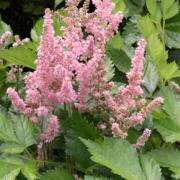 Astilbe chinensis—Chinese Astilbe
Astilbe chinensis—Chinese Astilbe
I have grown the original A. chinensis cv. ‚ÄòVisions’ (a strong dark pink with upright flower stalks) for many years and give it highest marks. It seems sturdier than most of the A. arendsii hybrids on the market. Mine is sited in moist, organic soils in part shade. If it gets too much sun or dries out, the edges will burn, like most astilbes. My clumps have been growing gradually larger over the years. I divided some and moved them to the edge of a woodland garden, where they make a dramatic focal point when they’re in bloom. The very attractive foliage starts out with a bronze tint in the spring, and then turns greener in the summer. I look forward to trying the pale pink and white versions of this outstanding plant.
Judy Snow
Ornamental grasses come and go in popularity but serve so many purposes that a collection of different types can enhance your overall design.
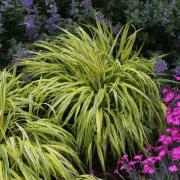 Grasses have more than one season of interest and there are grasses that flower in Spring, Summer, and Autumn. Some even have spectacular Fall color. If left standing over the winter, grasses provide a strong element in the landscape.
Grasses have more than one season of interest and there are grasses that flower in Spring, Summer, and Autumn. Some even have spectacular Fall color. If left standing over the winter, grasses provide a strong element in the landscape.
Grasses are unequaled in bringing texture and sound to the garden. The sound of the wind rustling through grass is soothing and tranquil. There are tall grasses and short ones, fine textured and impressive, with wonderful flowers. Grasses for sun and shade.
There is a grass for every garden.Some are fillers, some are ground covers, some are container plants,some make a very strong statement and all are deer resistant.
Here are a few of my favorites:
Hakonechloa macra is not particularly colorful but it makes an impressive statement planted en masse or mixed in a perennial border, or grown in a container. It cascades gracefully at about two feet. It grows more quickly, tolerates more sun and is very hardy. My collection of grasses would not be complete without it.
Hakonchloa macra ‘Aurieola’ is a beacon in the shady garden. It grows more slowly than macra but is well worth the wait. It looks beautiful cascading over a wall or the side of a container.
 Panicum North Wind A tall upright blue grass growing to five feet with airy white plumes in September makes a statement in the border and remains upright through the winter.
Panicum North Wind A tall upright blue grass growing to five feet with airy white plumes in September makes a statement in the border and remains upright through the winter.
Carex Ice Cream Although technically a sedge, C. Ice Cream reminds me of Cousin It from the Adams Family. A rich green with creamy white stripes growing to two feet it makes an excellent ground cover in the shade.
Sue Acheson
![]()
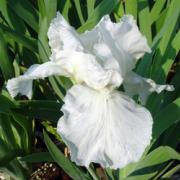
I think of irises the same way I feel about comfort food. It was a plant that was in my grandmother’s garden, and probably there before her time too. The cheery flowers, the pale green, swordlike foliage, and upright stance are valuable assets to any garden. And there is a wide variety of cultivars are available for varied sites and soil conditions.
Iris germanica, or the familiar bearded iris, has an amazing array of colors. Earl of Essex has white petals stippled and edged in violet, and has the distinction of being a rebloomer. Feed-Back is fragrant and a stunning blue-violet. Immortality (at right) is fragrant too, with ruffled soft white petals and pale lemon beards. It is also a rebloomer, as is Clarence, a near white with light blue falls. Jurassic Park has a buttercup yellow standard and lavender falls, and is a multiple award winner in the iris world.
The variety Iris pallida ‚ÄòArgentea Variegata’ (below) features soft green leaves with creamy white edges and a violet flower. The foliage makes it a standout in the garden.
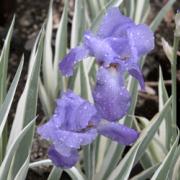
Iris ensata or Japanese Water Iris lives happily in wet sites, unlike its bearded cousin. It is also tolerant of partial shade. Fortune has purple falls while Loyalty is deep purple with yellow stripes on purple crests. Lion King is a collector’s favorite with strong white centers edged in deep violet. And Rose Queen is a delicate beauty with a unique pale rose pink hue and flowers in a pendant form.
Last but not least is Iris siberica or Siberian iris, with grasslike leaves topped by showy, beardless flowers. Tolerant of both wet and dry sites, Caesar’s Brother is a deep blue violet. White Swirl is similarly site tolerant, with a yellow throat surrounded by creamy white petals.
All irises are low maintenance and have that all important feature, great deer resistance.
Sally Hemsen